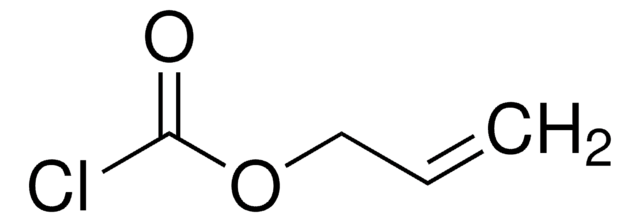379115
DCC
1.0 M in methylene chloride, for peptide synthesis
Sinonimo/i:
N,N′-Dicyclohexylcarbodiimide solution
About This Item
Prodotti consigliati
product name
DCC, 1.0 M in methylene chloride
Forma fisica
liquid
Impiego in reazioni chimiche
reaction type: Coupling Reactions
Concentrazione
1.0 M in methylene chloride
Densità
1.247 g/mL at 25 °C
applicazioni
peptide synthesis
Stringa SMILE
C1CCC(CC1)N=C=NC2CCCCC2
InChI
1S/C13H22N2/c1-3-7-12(8-4-1)14-11-15-13-9-5-2-6-10-13/h12-13H,1-10H2
QOSSAOTZNIDXMA-UHFFFAOYSA-N
Informazioni sul gene
human ... EPHX2(2053)
mouse ... Ephx2(13850)
Cerchi prodotti simili? Visita Guida al confronto tra prodotti
Categorie correlate
Applicazioni
Avvertenze
Danger
Indicazioni di pericolo
Consigli di prudenza
Classi di pericolo
Acute Tox. 4 Dermal - Carc. 2 - Eye Dam. 1 - Skin Irrit. 2 - Skin Sens. 1 - STOT SE 3
Organi bersaglio
Central nervous system
Codice della classe di stoccaggio
6.1C - Combustible acute toxic Cat.3 / toxic compounds or compounds which causing chronic effects
Classe di pericolosità dell'acqua (WGK)
WGK 3
Dispositivi di protezione individuale
Faceshields, Gloves, Goggles, type ABEK (EN14387) respirator filter
Certificati d'analisi (COA)
Cerca il Certificati d'analisi (COA) digitando il numero di lotto/batch corrispondente. I numeri di lotto o di batch sono stampati sull'etichetta dei prodotti dopo la parola ‘Lotto’ o ‘Batch’.
Possiedi già questo prodotto?
I documenti relativi ai prodotti acquistati recentemente sono disponibili nell’Archivio dei documenti.
I clienti hanno visto anche
Il team dei nostri ricercatori vanta grande esperienza in tutte le aree della ricerca quali Life Science, scienza dei materiali, sintesi chimica, cromatografia, discipline analitiche, ecc..
Contatta l'Assistenza Tecnica.













